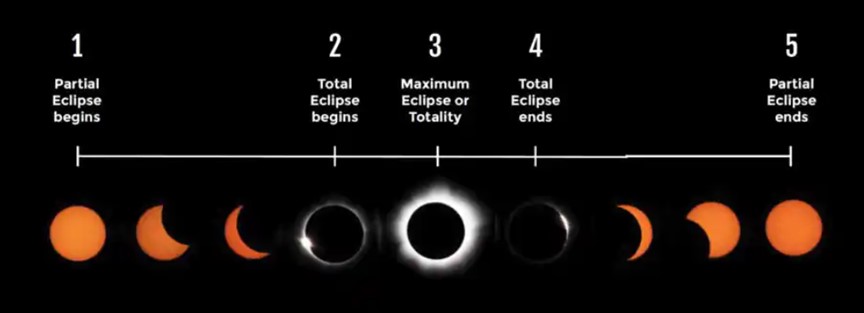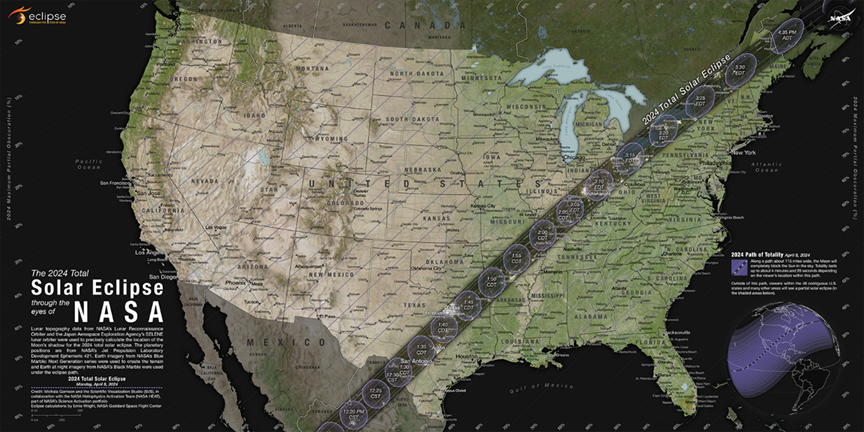Introduction
A total solar eclipse will cross over parts of North America on April 8th, and can be experienced throughout the continental United States, ranging from Texas to Maine. While this celestial event will likely be celebrated and observed by millions, eye safety is a priority in understanding how to prepare for this unique opportunity.
What is a Total Solar Eclipse?
According to the National Aeronautics and Space Administration (NASA), a solar eclipse occurs when the Sun, Moon, and Earth line up partially or totally. A total solar eclipse occurs when the Moon passes between the Sun and Earth, completely blocking the Sun momentarily. For this reason, it is essential to understand eye safety while viewing a partial solar eclipse or a total solar eclipse1.

Five stages of a total solar eclipse image. Source: https://solareclipseguide.com/5-stages-of-an-eclipse/
Vision Health and Eye Protection
Staring directly at a solar eclipse, even for seconds without specialized solar filters, can result in damage to the eye with temporary or permanent vision loss. The most common vision injury that can happen is “solar retinopathy” – damage to the back of the eye, to the cells in the retina. Unfortunately, there is no clinical treatment for solar retinopathy. Understanding the potential risks and actively participating in safe viewing practices is crucial to avoid eye injuries3,4.
Recommendations for Safe Eclipse Viewing
- Use Certified Eclipse Viewing Glasses: According to NASA, always wear eclipse viewing glasses (which have special filters for direct sun observation) while observing the partial phases of an eclipse. Ensure that eclipse viewing glasses meet international safety standards (ISO 12312-2)3,4. Regular glasses, contact lenses, and sunglasses are NOT sufficient for solar viewing.
- Inspect Your Eclipse Viewing Glasses: Before using approved eclipse viewing glasses, carefully inspect them for any damage or scratches. Do not use compromised glasses, as this can lead to eye damage4.
- Use Solar Filters for Optical Devices: You must use special-purpose solar filters in front of the binoculars, telescopes, smartphones, or camera lenses 5. Using optical devices without solar filters do not protect your eyes from UV damage. While using a smartphone remember to look at the phone screen, and not at the sun directly when taking your photos or videos5.
- Stay Informed: Know the timing and path of the eclipse and plan to observe it from a safe location. Be aware of when totality will occur in your area 5.
- Educate Others: Share information about safe eclipse viewing practices with friends, family, children, and the community. Make sure everyone uses proper eye protection, and especially supervise children by keeping eclipse viewing glasses over their eyes for the entire event. Consider having extra eclipse viewing glasses to share5,6. For more information visit: https://science.nasa.gov/eclipses/safety/.
For specific timings and locations of the total solar eclipse, refer to the map below 7.

Source: NASA
References:
- Types of Solar Eclipses - NASA science. NASA. Accessed February 8, 2024. https://science.nasa.gov/eclipses/types/.
- Stages of a Total Eclipse. Solar Eclipse Guide. January 20, 2023. Accessed February 8, 2024. https://solareclipseguide.com/5-stages-of-an-eclipse/.
- International Organization for Standardization ISO 12312-2:2015. ISO. September 28, 2020. Accessed February 8, 2024. https://www.iso.org/standard/59289.html.
- Safety - NASA Science. NASA. Accessed February 8, 2024. https://science.nasa.gov/eclipses/safety/.
- Safety - NASA Science. NASA. Accessed February 8, 2024. https://science.nasa.gov/eclipses/future-eclipses/eclipse-2024/safety/.
- How to view a solar eclipse safely. Solar Eclipse Across America. January 16, 2024. Accessed February 8, 2024. https://eclipse.aas.org/eye-safety.
- 2024 Total Eclipse: Where & when - NASA science. NASA. Accessed February 8, 2024. https://science.nasa.gov/eclipses/future-eclipses/eclipse-2024/where-when/.
back to top